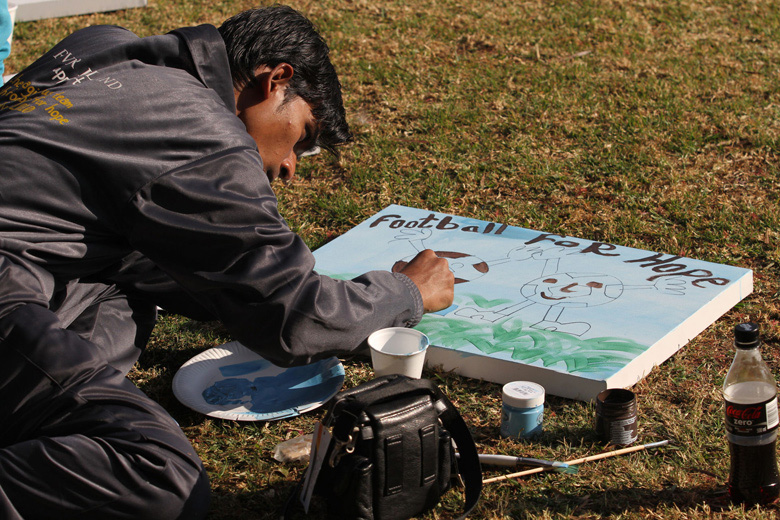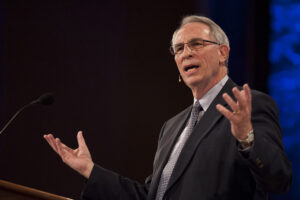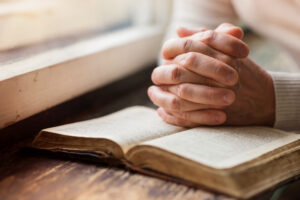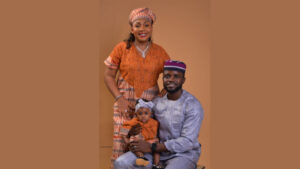
JOHANNESBURG, South Africa (BP)–The feet seem to move furiously across the canvas, black swirls indicating a sense of near-frantic excitement.
The painting is titled “Diskiology,” referring to the soccer-inspired Diski Dance that captivated fans during South Africa’s World Cup.
But it conveys much more than a dance.
The piece of art portrays the thrill of a nation — in fact, a continent -– that finally had an opportunity to host the world’s largest sporting event. It illustrates the determined movement of athletes toward a goal, desperate to move forward to the next level of competition, and the enthusiasm of fans jumping to their feet when the goal is scored.
Also reflected in the painting are the vendors, sponsors, churches and nonprofit organizations that worked non-stop throughout the World Cup.
Like sports, art has the power to unify, to uplift and inspire, to communicate volumes without speaking a word.
“It’s all about creativity and discipline,” pop artist Romero Britto, who participated in FIFA’s Football for Hope Festival, said about the way soccer and art complement one another. “… You can have the creativity of someone playing the game … and the discipline also of the sports. You need to have those two things together.”
Brazilian-born Britto used his art to inspire delegates from 32 nations during the Football for Hope Festival in Johannesburg in which teenagers used acrylics to paint messages of soccer, hope and national pride on 32 canvases.
A similar theme of the unifying power of sports was promoted in various art exhibits around Johannesburg during the World Cup competition.
South African and Brazilian artists collaborated for an exhibit at the Commerzbank Building. Brazil will host the World Cup in 2014, so the exhibit was a collection of soccer-inspired fine art pieces from the two countries, including “Diskiology” by Johannesburg resident David Koloane.
The Nelson Mandela Foundation featured “Africa Salutes You,” an exhibit of 32 Athol Moult paintings inspired by the nations that competed in this year’s World Cup. The foundation used the paintings to welcome the world to Africa’s first World Cup and to raise awareness of Mvezo, one of South Africa’s poorest villages. The children of Mvezo helped create the paintings.
In addition to fine art, artwork at the local level also made an impact during the World Cup.
In June, when thousands of fans from around the world were in Johannesburg for the opening ceremonies and first round of competition, business at Rosebank’s African Craft Market was booming as tourists purchased carvings, masks, jewelry and other handicrafts.
A popular souvenir was the “love-it-or-hate-it” noisemaker that has become synonymous with South African soccer — the vuvuzela. While a simple plastic vuvuzela was priced from $2.50 to $5.50, those covered with intricate beading representing the handicraft of the Zulu and Ndebele ethnic groups, were sold for as much as $53.
When asked whom he wanted to win the tournament, one vendor replied, “Germany … They are good buyers! For us, it’s about business.”
But for some Christian artists, the World Cup wasn’t about sports or business: It was about using the arts to creatively share the Gospel of Jesus Christ.
Arts in Action, a creative arts ministry in South Africa, organized dramas, dance performances and worship events to point soccer fans to the greatest Creator of all.
“There’s a common bond here, through the creative arts. You don’t need to speak their language. They don’t need to speak my language. It’s a universal language,” said Lecia Hale, a dance instructor and the Arts in Action coordinator in Durban. “… I believe that dance, besides being a universal language, can also speak to a hardened heart or a hurting heart.”
Hale said creative arts can help unify South Africans, who have a history of bitter racial division.
As she danced during an outreach in Durban’s Newlands East, an impoverished township she otherwise might never have visited, Hale said she “felt lifted … because I saw the oneness, I saw the unity” that her form of art inspired.
In all its forms, art, like sports, can inspire communities, impart culture and point people to the Creator God. “If you do [something] really well, you should share how you do it or share what you have,” Britto said. “And then the world would be a better place.”
–30–
Melanie Clinton writes for the International Mission Board’s global communication team.
















